In looking back at the bounty of nonfiction (including informational books, biographies, and poetry) published in 2017, we have considered the diversity of reading interests of children and young adults and the identification of outstanding trade books with curriculum connections as well as our favorites among the many books we have read this year. Here are our picks of the best nonfiction of 2017.
Ages 4–8
All Ears, All Eyes. Richard Jackson. Ill. Katherine Tillotson. 2017. Caitlyn Dlouhy/Atheneum/Simon & Schuster.
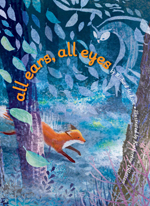 A spare lyrical text and beautiful impressionistic illustrations invite readers to listen to the sounds and look closely at the sights of the forest from twilight to dark of night. With a mix of questions, rhyming phrases, and onomatopoeia, the gentle text reads aloud well. “What surprises? / What sings? / Crick-crick-crickets / chirring / in the thick-thick-thickets / Whoo–whoo.”
A spare lyrical text and beautiful impressionistic illustrations invite readers to listen to the sounds and look closely at the sights of the forest from twilight to dark of night. With a mix of questions, rhyming phrases, and onomatopoeia, the gentle text reads aloud well. “What surprises? / What sings? / Crick-crick-crickets / chirring / in the thick-thick-thickets / Whoo–whoo.”
Balderdash!: John Newbery and the Boisterous Birth of Children’s Books. Michelle Markel. Ill. Nancy Carpenter. 2017. Chronicle.
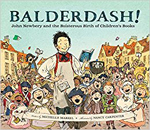 Book lover John Newbery believed that reading should be a treat for children, and his first book for children, A Little Pretty Pocket-Book, was just that. Newbery’s success in publishing delightful books for young people earned him the title of “Father of Children’s Literature.” Detailed illustrations set the scene and match the wit of this engaging biography.
Book lover John Newbery believed that reading should be a treat for children, and his first book for children, A Little Pretty Pocket-Book, was just that. Newbery’s success in publishing delightful books for young people earned him the title of “Father of Children’s Literature.” Detailed illustrations set the scene and match the wit of this engaging biography.
Grand Canyon. Jason Chin. 2017. Neal Porter/Roaring Brook.
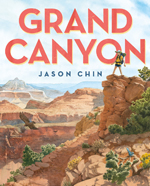 This informational picture book, in which a father and daughter explore the Grand Canyon, includes sidebars detailing the geology and ecology of the canyon and borders picturing its rock strata, fauna, and flora. The illustrations showcase the majesty of the canyon. The book ends with a double gatefold showing the two explorers overlooking “the greatest canyon on Earth.”
This informational picture book, in which a father and daughter explore the Grand Canyon, includes sidebars detailing the geology and ecology of the canyon and borders picturing its rock strata, fauna, and flora. The illustrations showcase the majesty of the canyon. The book ends with a double gatefold showing the two explorers overlooking “the greatest canyon on Earth.”
I’m Just No Good at Rhyming: And Other Nonsense for Mischievous Kids and Immature Adults. Chris Harris. Ill. Lane Smith. 2017. Little, Brown.
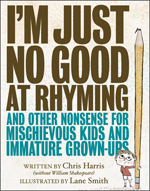 As the blurb on the book jacket flap promises, this is a “radically INVENTIVE, ABSURDLY FUNNY (and a little bit NAUGHTY) collection of wildly witty words (aka poetry).” The verbal and visual humor of this anthology of more than 100 poems on crazy topics, such as a unipede that is “So sick and tired . . . / of hoppin’!” and an island where everyone is named Toby, is laugh-out-loud delightful.
As the blurb on the book jacket flap promises, this is a “radically INVENTIVE, ABSURDLY FUNNY (and a little bit NAUGHTY) collection of wildly witty words (aka poetry).” The verbal and visual humor of this anthology of more than 100 poems on crazy topics, such as a unipede that is “So sick and tired . . . / of hoppin’!” and an island where everyone is named Toby, is laugh-out-loud delightful.
Rivers of Sunlight: How the Sun Moves Water Around the Earth. (Sunlight Series). Molly Bang & Penny Chisholm. Ill. Molly Bang. 2017. Blue Sky/Scholastic.
 With expressive text and stunning illustrations, Bang and Chisholm present an accessible explanation of the role the sun plays in the water cycle. The text, narrated by the sun, ends with a call for readers to do their part to use water wisely and keep it clean.
With expressive text and stunning illustrations, Bang and Chisholm present an accessible explanation of the role the sun plays in the water cycle. The text, narrated by the sun, ends with a call for readers to do their part to use water wisely and keep it clean.
The World Is Not a Rectangle: A Portrait of Architect Zaha Hadid. Jeanette Winter. 2017. Beach Lane/Simon & Schuster.
 Winter’s picture book biography introduces Zaha Hadid (1950–2016), an Iraqi-born, British-educated architect, whose childhood interests in the natural world influenced her innovative and controversial architectural designs. Though her early designs for structures largely remained unbuilt, her imaginative designs are now buildings all over the world.
Winter’s picture book biography introduces Zaha Hadid (1950–2016), an Iraqi-born, British-educated architect, whose childhood interests in the natural world influenced her innovative and controversial architectural designs. Though her early designs for structures largely remained unbuilt, her imaginative designs are now buildings all over the world.
Ages 9–11
Before She Was Harriet. Lesa Cline-Ransome. Ill. James E. Ransome. 2017. Holiday House.
 A dramatic cumulative poem and expressive paintings present periods of the life of Harriet Tubman as suffragist, Union Army spy, Underground Railroad conductor, slave in Maryland, and Araminta, “a young girl / taught by her father / to read / the woods / and the stars at night / readying / for the day / she’d leave behind / slavery / along with her name / and pick a new one / Harriet.”
A dramatic cumulative poem and expressive paintings present periods of the life of Harriet Tubman as suffragist, Union Army spy, Underground Railroad conductor, slave in Maryland, and Araminta, “a young girl / taught by her father / to read / the woods / and the stars at night / readying / for the day / she’d leave behind / slavery / along with her name / and pick a new one / Harriet.”
Her Right Foot. Dave Eggers. Ill. Shawn Harris. 2017. Chronicle.
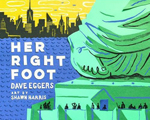 This beautifully-crafted book is more than just a history of the Statue of Liberty. By focusing on the statue’s raised right foot (“This 150-foot woman is on the go!”), Eggers and Harris offer a timely reminder of our country’s history as a nation of immigrants. The Statue of Liberty is not just standing still, she is striding toward the sea to welcome immigrants to the United States of America.
This beautifully-crafted book is more than just a history of the Statue of Liberty. By focusing on the statue’s raised right foot (“This 150-foot woman is on the go!”), Eggers and Harris offer a timely reminder of our country’s history as a nation of immigrants. The Statue of Liberty is not just standing still, she is striding toward the sea to welcome immigrants to the United States of America.
The Secret Project. Jonah Winter. Ill. Jeanette Winter. 2017. Beach Lane/Simon & Schuster.
 Spare text and folk art-style illustrations present a history of the development of the atomic bomb at a remote site in New Mexico in 1943. The project’s secrecy is expressed in the contrast between the colorful desert landscape and the gray-black silhouettes of “shadowy figures” (scientists) working day and night. The countdown for the bomb test is followed by wordless pages showing stages of the explosion—and a black final page.
Spare text and folk art-style illustrations present a history of the development of the atomic bomb at a remote site in New Mexico in 1943. The project’s secrecy is expressed in the contrast between the colorful desert landscape and the gray-black silhouettes of “shadowy figures” (scientists) working day and night. The countdown for the bomb test is followed by wordless pages showing stages of the explosion—and a black final page.
Silent Days, Silent Dreams. Allen Say. 2017. Scholastic.
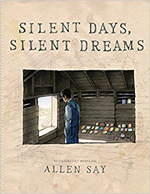 Say’s fictional biography of James Castle (1899–1977) is a tribute to the deaf, autistic, self-taught artist, who created thousands of pieces of art during his silent and solitary lifetime. The extensive author’s note details how Say came to create this “imagined biography of a most original and enigmatic artist” in which he emulates the artist’s style in many of the illustrations.
Say’s fictional biography of James Castle (1899–1977) is a tribute to the deaf, autistic, self-taught artist, who created thousands of pieces of art during his silent and solitary lifetime. The extensive author’s note details how Say came to create this “imagined biography of a most original and enigmatic artist” in which he emulates the artist’s style in many of the illustrations.
The Whydah: A Pirate Ship Feared, Wrecked, and Found. Martin W. Sandler. 2017. Candlewick.
 The Whydah, which sunk off the coast of Cape Cod during a storm on April 26, 1717, and was found in 1985, is the only pirate shipwreck that has been authenticated. Evidence from marine archaeologists, factual inserts, and Sandler’s research present an accurate representation of the lives of pirates. Back matter includes source notes, a bibliography, and index.
The Whydah, which sunk off the coast of Cape Cod during a storm on April 26, 1717, and was found in 1985, is the only pirate shipwreck that has been authenticated. Evidence from marine archaeologists, factual inserts, and Sandler’s research present an accurate representation of the lives of pirates. Back matter includes source notes, a bibliography, and index.
Ages 12–14
A Dog in the Cave: The Wolves Who Made Us Human. Kay Frydenborg. 2017. Houghton Mifflin Harcourt.
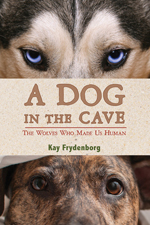 In this exploration of the human-dog relationship, Frydenborg considers how a shared history has influenced the development of both humans and canines. Recent paleontological discoveries show that humans have been living with dogs for thousands of years longer than was previously thought and provide evidence that this close relationship has shaped both species.
In this exploration of the human-dog relationship, Frydenborg considers how a shared history has influenced the development of both humans and canines. Recent paleontological discoveries show that humans have been living with dogs for thousands of years longer than was previously thought and provide evidence that this close relationship has shaped both species.
Fault Lines in the Constitution: The Framers, Their Fights and the Flaws That Affect Us Today. Cynthia Levinson & Sanford Levinson. 2017. Peachtree.
 The Levinsons provide a thought-provoking exploration of the U.S. Constitution, examining the Framers’ “fights” during the Constitutional Convention in 1787 and the Constitution’s “flaws” that have affected the country throughout history. The clear narrative style, supplemented by striking infographics, considers provisions of the Constitution, resulting “big problems,” and connections to present-day issues. The authors end with a grading of the Constitution in terms of its successes and problems based on the goals set out in the Preamble—an overall C+.
The Levinsons provide a thought-provoking exploration of the U.S. Constitution, examining the Framers’ “fights” during the Constitutional Convention in 1787 and the Constitution’s “flaws” that have affected the country throughout history. The clear narrative style, supplemented by striking infographics, considers provisions of the Constitution, resulting “big problems,” and connections to present-day issues. The authors end with a grading of the Constitution in terms of its successes and problems based on the goals set out in the Preamble—an overall C+.
Isaac the Alchemist: Secrets of Isaac Newton, Reveal’d. Mary Losure. 2017. Candlewick.
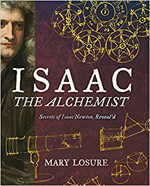 In the prologue to this biography of Isaac Newton (1642–1727), Losure affirms, “He would become the world’s greatest alchemist. He would also (by following his own odd and lonely path) become one of the greatest scientists who ever lived.” The narrative account of Newton’s life and work, illustrated with engravings and pages from Newton’s notebooks and published works, supports this statement.
In the prologue to this biography of Isaac Newton (1642–1727), Losure affirms, “He would become the world’s greatest alchemist. He would also (by following his own odd and lonely path) become one of the greatest scientists who ever lived.” The narrative account of Newton’s life and work, illustrated with engravings and pages from Newton’s notebooks and published works, supports this statement.
One Last Word: Wisdom from the Harlem Renaissance. Nikki Grimes. 2017. Bloomsbury.
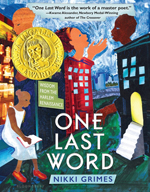 Grimes pairs original poems, written in the “Golden Shovel” format (explained in an introductory “Poetry Form” note), with poems by Harlem Renaissance poets, such as Langston Hughes and Paul Laurence Dunbar, and artwork by inspiring contemporary African American illustrators. Back matter includes biographical notes on the poets and artists, sources, and an index.
Grimes pairs original poems, written in the “Golden Shovel” format (explained in an introductory “Poetry Form” note), with poems by Harlem Renaissance poets, such as Langston Hughes and Paul Laurence Dunbar, and artwork by inspiring contemporary African American illustrators. Back matter includes biographical notes on the poets and artists, sources, and an index.
The Photo Ark: One Man’s Quest to Document the World’s Animals. Joel Sartore. 2017. National Geographic.
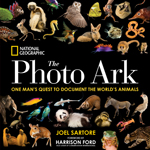 This pictorial encyclopedia showcasing the diversity of animals on our planet features portraits of more than four hundred animals. Each photo is captioned with the common and the scientific name of the animal and a notation of the species’ conservation status. Inserts on eight “heroes,” conservationists acting to protect the Earth’s biodiversity, add interest. Back matter includes notes on the making of the photographs and National Geographic’s Photo Ark Project.
This pictorial encyclopedia showcasing the diversity of animals on our planet features portraits of more than four hundred animals. Each photo is captioned with the common and the scientific name of the animal and a notation of the species’ conservation status. Inserts on eight “heroes,” conservationists acting to protect the Earth’s biodiversity, add interest. Back matter includes notes on the making of the photographs and National Geographic’s Photo Ark Project.
Sinking the Sultana: A Civil War Story of Imprisonment, Greed, and a Doomed Journey Home. Sally M. Walker. 2017. Candlewick.
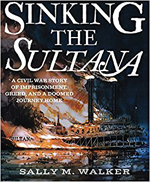 Walker gives an account of the 1865 sinking of a steamboat, the Sultana, on the Mississippi River with over 2,000 passengers aboard, including formerly imprisoned Union soldiers. This engaging history of “the worst maritime disaster in American history” includes diagrams, maps, and archival photographs. Back matter includes an author’s note, glossary, source notes, bibliography, and index.
Walker gives an account of the 1865 sinking of a steamboat, the Sultana, on the Mississippi River with over 2,000 passengers aboard, including formerly imprisoned Union soldiers. This engaging history of “the worst maritime disaster in American history” includes diagrams, maps, and archival photographs. Back matter includes an author’s note, glossary, source notes, bibliography, and index.
Ages 15+
Alexander Hamilton: Revolutionary. Martha Brockenbrough. 2017. Feiwel and Friends.
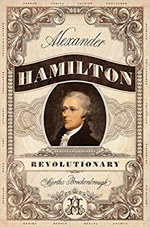 Brockenbrough’s well-researched, in-depth biography of Alexander Hamilton covers his life and the important roles he played in the early history of America, from his illegitimate birth in the West Indies in 1755 to his death in a duel with Aaron Burr in 1804. The extensive back matter includes a family tree, a list of Hamilton’s allies and enemies, short entries on related topics, a time line, a bibliography, source notes, and an index.
Brockenbrough’s well-researched, in-depth biography of Alexander Hamilton covers his life and the important roles he played in the early history of America, from his illegitimate birth in the West Indies in 1755 to his death in a duel with Aaron Burr in 1804. The extensive back matter includes a family tree, a list of Hamilton’s allies and enemies, short entries on related topics, a time line, a bibliography, source notes, and an index.
Victoria: Portrait of a Queen. Catherine Reef. 2017. Clarion/Houghton Mifflin Harcourt.
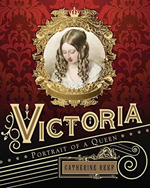 With a masterful storytelling voice, Reef offers readers a fascinating biography of Victoria, who became Queen of the United Kingdom of Great Britain and Ireland in 1837—at age 18—and ruled until her death in 1901. The engaging narrative, enriched by a wealth of illustrations (including full-color formal portraits and archival paintings) provides a vivid portrait of the long-reigning queen and a history of the era in which she lived. Back matter includes a list of British monarchs, Queen Victoria’s family tree, source notes, an extensive bibliography, picture credits, and an index.
With a masterful storytelling voice, Reef offers readers a fascinating biography of Victoria, who became Queen of the United Kingdom of Great Britain and Ireland in 1837—at age 18—and ruled until her death in 1901. The engaging narrative, enriched by a wealth of illustrations (including full-color formal portraits and archival paintings) provides a vivid portrait of the long-reigning queen and a history of the era in which she lived. Back matter includes a list of British monarchs, Queen Victoria’s family tree, source notes, an extensive bibliography, picture credits, and an index.
Vincent and Theo: The Van Gogh Brother. Deborah Heligman. 2017. Henry Holt.
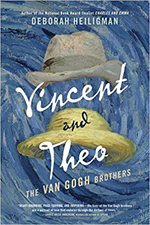 This insightful biography portrays the complicated life-long relationship between artist Vincent van Gogh (1853–1890) and his younger brother, Theo (1857–1891). Double-page sketches of the artist’s work at the beginning of the chronologically arranged “galleries” (sections of the book) and an eight-page insert of full-color photographs of Vincent van Gogh’s major works, including a self-portrait (1887) and a portrait of Theo van Gogh (1887), and back matter (time line, author’s note, extensive bibliography, source notes, and index) contribute to this engaging, well-researched tribute to the Van Gogh brothers.
This insightful biography portrays the complicated life-long relationship between artist Vincent van Gogh (1853–1890) and his younger brother, Theo (1857–1891). Double-page sketches of the artist’s work at the beginning of the chronologically arranged “galleries” (sections of the book) and an eight-page insert of full-color photographs of Vincent van Gogh’s major works, including a self-portrait (1887) and a portrait of Theo van Gogh (1887), and back matter (time line, author’s note, extensive bibliography, source notes, and index) contribute to this engaging, well-researched tribute to the Van Gogh brothers.
Nancy Brashear is Professor Emeritus of English at Azusa Pacific University, in Azusa, California. Carolyn Angus is former Director of the George G. Stone Center for Children's Books, Claremont Graduate University, in Claremont, California.
These reviews are submitted by members of the International Literacy Association's Children's Literature and Reading Special Interest Group (CL/R SIG) and are published weekly on Literacy Daily.